All entries for Wednesday 24 August 2022
August 24, 2022
Faces from the past – "Aline" and her children by Jacqui Butler
The Fayum portraits from Roman Egypt which are dated to the first to third centuries AD, are amongst the most captivating and poignant artefacts to survive from the ancient world, providing us with visual representations of how the people beneath the mummy wrappings might have looked in life. The portraits are evocative memorials and can be quite moving, with the deceased often depicted looking directly out at the viewer, inviting engagement with their image. They are all the more valuable given the lack of painted portraiture which survives from antiquity, as although marble portraiture survives in quantity, allowing us a similar look at the features of the dead, these painted images are more realistic, more evocative, and more engaging.
The portraits appear on a variety of media and incorporate different techniques; some show whole figures whilst others depict only the head and face. Some are likely to have been painted in life and kept until the death of the subject, whilst others would have been painted posthumously. Many are very sophisticated and high-quality works of art, portraying their subjects in a naturalistic manner, likely reflecting a degree of Greek influence in this regard, whilst others are stylised in different ways or are much more simplistic. They are of course a product of the society which created them; rather than an amalgamation of Greek, Roman and other cultural influences, Egypt maintained much of its own cultural identity and customs alongside these. Mummification to preserve the physical form, which was considered essential for life after death was, of course, an Egyptian ritual religious practise, and the portraits can be understood to reflect a development in Egyptian funerary art. This unique addition of portraits to the mummies, which began during the reign of Tiberius (AD 14-37) often incorporated elements of Roman dress and adornment, reflecting this aspect of contemporaneous society in Egypt.
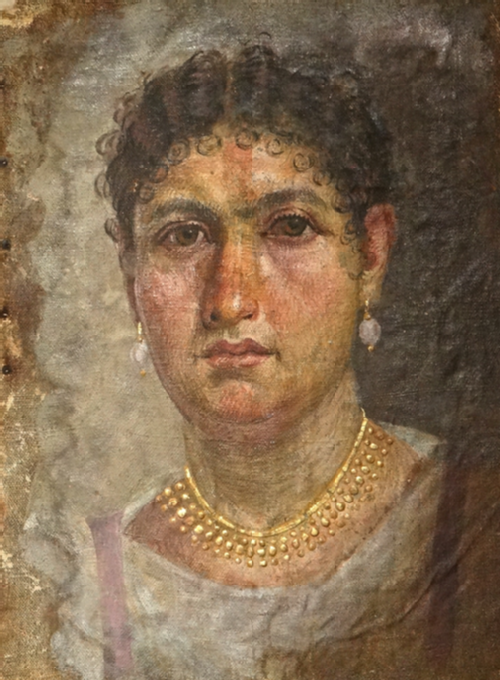 |
Fig. 1. “Mummy portrait of Aline”, Ägyptisches Museum, Staatliche Museen du Berlin, ID. No. AM 11411. Height: 42 cm; Width: 33cm; Depth: 2 cm. Creative Commons BY-NC-SA 4.0. |
I was drawn to this particular image of a woman, “Aline” (Fig. 1.), due to a discernible element of sadness within the portrait, which the painter has managed to convey in a very realistic, perhaps even veristic, image. Aline’s mummy was found in a burial pit alongside other members of her family and she can most likely be identified, from an inscribed limestone stele (Fig. 2.) found beside her.
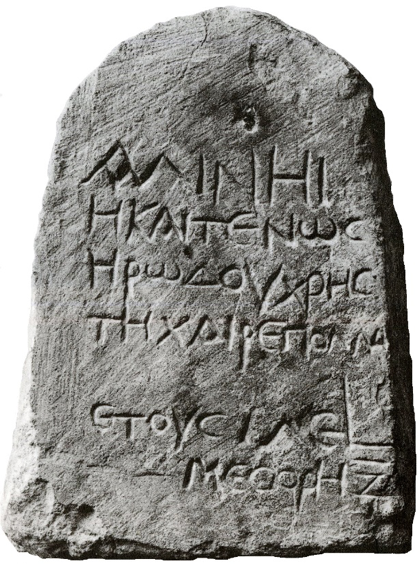 |
Fig. 2. “Stele with Greek inscription”, Ägyptisches Museum, Staatliche Museen du Berlin, ID. No. AM 11415. Height: 23 cm; Width: 16 cm. Now lost. Inscription translated by J. Moje as “ Aline|aka Tenos| (daughter) of Herod, the good| Greetings!| 10th year of reign. 35 years of life| 7 Mesore”. Creative Commons BY-NC-SA 4.0. |
The Roman era burial pit in which Aline’s mummy was found, was discovered at the end of March 1892, by Professor Richard von Kaufmann, a German art collector, who undertook a small excavation at Hawara in the Fayum. The pit dates to the first to second centuries CE, and contained eight mummies, two of which had gilded cartonnage masks, three with painted portraits and three others with no ornamentation. The burial pit has a shaft leading to it, about 1 metre deep, and the pit is 3.5 metres long and 2.8 metres wide. The mummies themselves were found stacked on top of each other: the mummy of Aline was at the bottom, lying on its side, with the mummies of two small children alongside her, and the inscribed stele at her head. Lying on top and across these, was the mummy of a man and a further child, both with the gilded masks, and on top of these, again laid cross-wise, were the three further undecorated mummies.
The mummy of both Aline and the man were unwrapped at the time of excavation in Hawara, with the gilded cartonnage mask of the man and portrait painting of Aline being transferred to Germany, together with the mummies of the three children. Somewhat gruesomely, the head of Aline’s mummy was removed (and is now lost) in order for a facial reconstruction to be created, to prove the similarity between the facial features of the mummy and the portrait. However, the facial features of her mummified head were not well preserved, and a reconstruction therefore proved difficult, although some similarity can be seen in a drawing taken from the head and superimposed onto another of the portrait.
Therefore, whether the mummy portrait of Aline was intended as a true likeness or whether it was an idealised portrait cannot be definitively verified. More likely it is a combination of the two, and a closer look at elements of Aline’s portrait, as well as the portraits of the two children may demonstrate this. All three of these portraits were painted directly onto the shrouds bound around the bodies and are lit from the right-hand side, which adds depth to the images. They share similarities in facial features, specifically in the shape of face and their lips, signifying their familial connection. It has been suggested that they were painted by the same artist, although Aline’s eyes are much more realistically depicted than those of the children. The jewellery Aline wears is highlighted by being painted in gold leaf on top of applied stucco, whilst the children’s mummies are decorated with similar button shapes (Figs. 3 and 4).
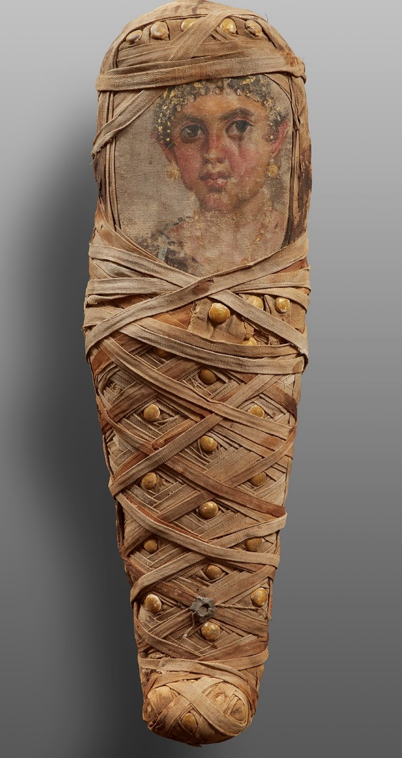 |
Fig. 3. “Mummy of a girl with mummy portrait (“Aline’s daughter”), Ägyptisches Museum, Staatliche Museen du Berlin, ID. No. AM 11412. Length: 83 cm; Width: 27 cm; Depth: 20 cm. Creative Commons BY-NC-SA 4.0. |
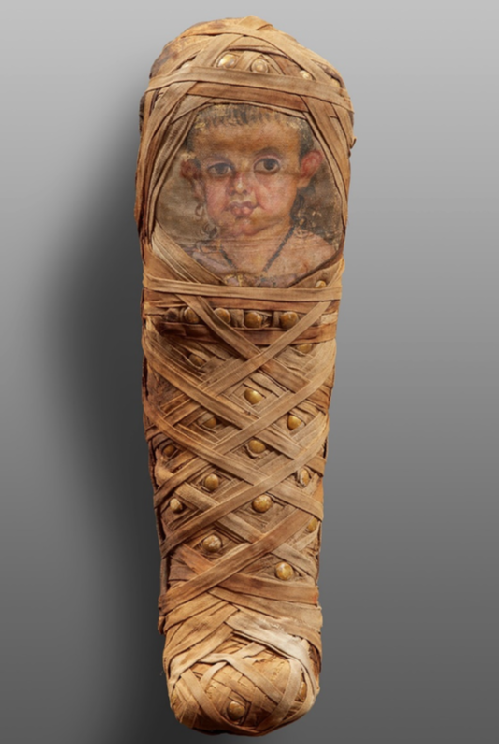 |
Fig. 4. “Mummy of a Male Child with Mummy Portrait (“Son of Aline”), Ägyptisches Museum, Staatliche Museen du Berlin, ID. No. AM 11413. Length: 78 cm; Width: 23 cm; Depth: 22 cm. Creative Commons BY-NC-SA 4.0. |
The dating of Aline’s portrait and those of her children are broadly given as within the first to second century CE timeframe, although some scholarship has suggested 69-117 CE. However, her hairstyle may suggest a slightly earlier dating of the middle of the first century CE. Indeed, Aline’s hairstyle shares some similarity with the so-called wife of Terentius Neo, who appears in one of the few paintings from Pompeii which can be identified as a portrait (Fig. 5.). This hairstyle is understood to have been popular around ca. 50 CE, but the Terentius Neo painting may not have been painted until towards the time of the Vesuvian eruption, and certain styles had some longevity, or came back into fashion at different times. It is also similarly represented on various statuary representations of Agrippina the Younger (14-59 CE) (for an example, please visit: https://www.uffizi.it/en/artworks/portrait-agrippina-younger%20). Therefore, Aline’s hairstyle, which does not have the same curls around the neck, may be an adaptation of the style which was popular from at least 50 CE onwards.
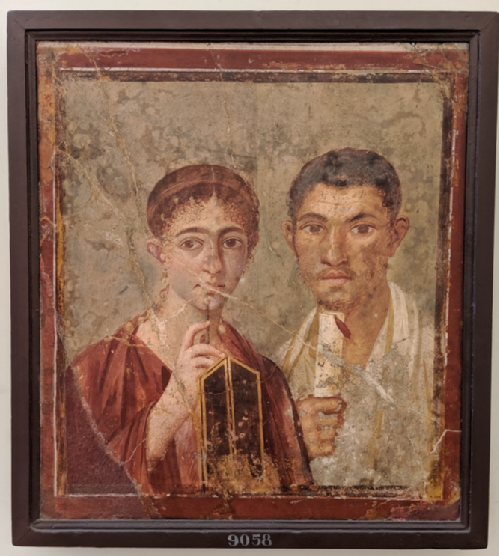 |
Fig. 5. Museo Archeologico Nazionale di Napoli Inv. No. 9058, Author’s own photograph. |
The jewellery Aline wears consists of a gold collar type of necklace made up of a plain, “strap”-type of chain, with pendant drops suspended from it, whilst the earrings she wears may be either pearls or other semi-precious gemstones, set in gold. Opulent jewellery is a striking feature of the Fayum portraits, and its inclusion here contrasts with the realism in the facial features of the portrait, and I would suggest that this may indicate some element of identity projection, to indicate wealth and status. It is worth noting that there is literary evidence for what seems to have been an Egyptian practice of keeping mummies in the home (Diodorus Siculus 1.92.6; Cicero, Tusculan Disputations, 1.45; Lucian, On Funerals, 21.) and this may even point to the existence of a specifically Egyptian domestic ancestral cult. Therefore, instead of being confined to a single funerary occasion, the mummies may have had much more visibility, with dress and jewellery being significant inclusions in the portraits as a means of identity projection.
The portrait of the young girl “Aline’s daughter” (Fig. 3) is portrayed with a gilded wreath in her hair, wearing a gold necklace (which probably had an apotropaic pendant) and with disc and ball earrings which were a popular shape in the first century AD and are seen on numerous Fayum portraits. The younger child, “Son of Aline” (Fig. 4) is also shown with a gilded wreath and a rope-type of necklace with three gold pendant shapes which are difficult to interpret. Scholarship has suggested that the two outer pendants are lunulae which are crescent shaped, and these are usually worn for protection by girls and women, and again many of these can be seen in other Fayum portraits. For this to appear on a boy’s portrait is highly unusual, and this together with the bare shoulders of the child and the use of the colour lilac for clothing, has led to the child previously being assumed to be female. However, the CT scans carried out in January 2016 showed that the child was in fact a boy, aged 2-3 years, whilst “Aline’s daughter” was no older than age 4, with the cause of death unknown in both cases.
The portrayal of the children wearing lavish jewellery is not unusual since other Fayum portraits of children show similar adornment. However, it struck me that the earrings worn by “Aline’s daughter” are rather large and are more often seen on adult women. Therefore, the portraits are not likely to reflect the reality of the children’s everyday attire, but rather how they would have been dressed for important life events, had they lived. The young girl’s earrings could also be understood as an expression of this in terms of the jewellery she would have worn had she lived to be older.
In conclusion, I think that the portraits of Aline and her two young children combine the realism of their facial features with some elements of idealisation. Whilst there may have been some concern to promote ideas of wealth and status to the contemporaneous world via the lavish adornment in the portraits, the true likeness of the person would have had equal importance given the potential of display in the domestic setting. It would also have been important that the deceased were as well prepared for the afterlife as they could be, as the portraits formed part of the immortal substitute for the deceased. The portraits certainly provide a poignant snapshot, and I wonder if the sadness in Aline’s face is because the two cherub-cheeked young children died shortly before her, or in the case that she died first, the painter either captured or imagined her sadness at leaving her children behind. We can only surmise.
Bibliography:
Bierbrier, M. (1997) Portraits and Masks, Burial Customs in Roman Egypt (London, British Museum Press).
Clarke, J. R. (2003) Art in the Lives of Ordinary Romans, Visual Representation and Non-Elite Viewers in Italy 100 BC-AD 315 (London, University of California Press.
Corcoran, L. H. (1995) Portrait Mummies from Roman Egypt (I-IV Centuries A.D.) with a Catalog of Potrait Mummies in Egyptian Museums, Studies in Ancient Oriental Civilization, No. 56 (Chicago, The Oriental Institute of the University of Chicago).
Doxiadis, E. (1995) The Mysterious Fayum Portraits, Faces from Ancient Egypt (London, Thames and Hudson).
Harlow, M. and Laurence, R. (2002) Growing up and Growing Old in Ancient Rome (London and New York, Routledge).
Helmbold-Doyé, J. (2017) Aline und ihre Kinder: Mumien aus dem römerzeitlichen Ägypten (Wiesbaden, Reichert).
Helmbold-Doyé, J. (2022) “Mummy portrait of Aline” online at: https://recherche.smb.museum/detail/607538
Germer, R. Kischkewitz, H. and Lüning, M. (1993) “Das Grab der Aline und die Untersuchung der darin gefundenen Kindermumien”, Antike Welt, 1993, Vol. 24, No. 3, pp. 186-196.
Moje, J. (2022) “Stele with Greek inscription” online at: https://recherche.smb.museum/detail/761702
Newby, Z. (2019) ‘The Grottarossa doll and her mistress: hope and consolation in Roman tomb’, in The Materiality of Mourning: Cross-Disciplinary Perspectives, eds. Z. Newby and R. E. Toulson. (London and New York, Taylor and Francis) pp. 77-102.
Walker, S. and Bierbrier, M. (1997) Ancient Faces, Mummy Portraits from Roman Egypt (London, British Museum Press).
Afterword:
In 2018, staff and students in the Department of Classics and Ancient History had the opportunity to participate in a “Mummy Portrait Painting Workshop”, organised by Dr. Helen Ackers. We were able to learn about the production of the paintings and the different techniques used, as well as having the fantastic hands-on experience of trying to create our own portraits. You can read about the workshop here.

 Jacqui Butler
Jacqui Butler

 Please wait - comments are loading
Please wait - comments are loading
 Loading…
Loading…